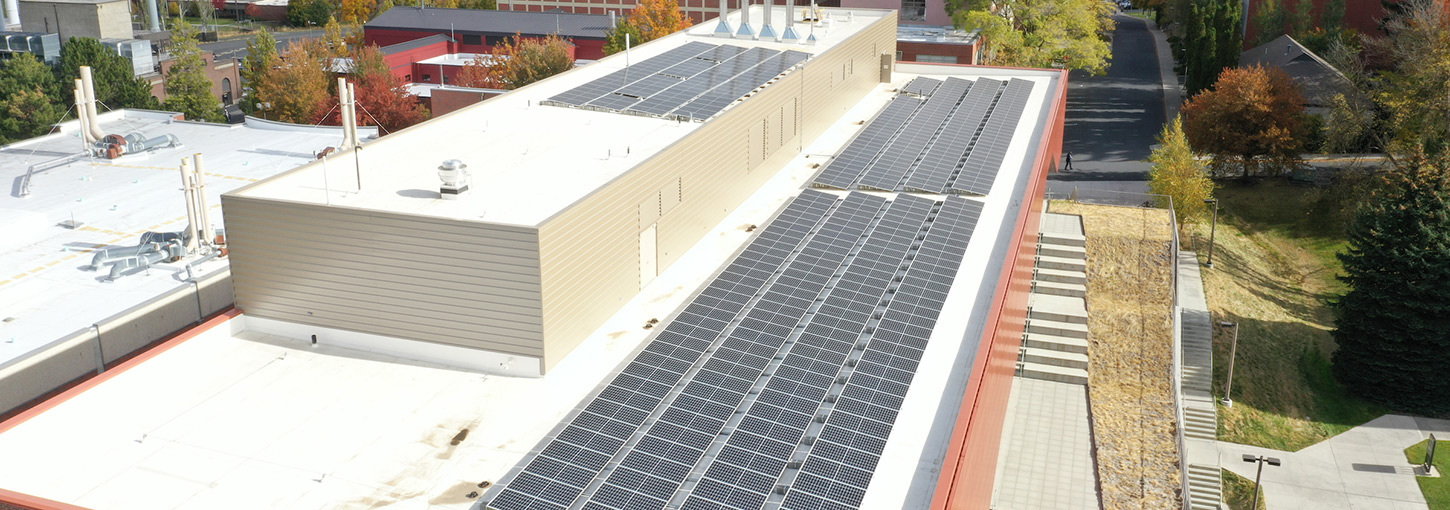Energy
As a signatory of two climate agreements – the Talloires Declaration and the Presidents’ Climate Leadership Commitment – the University of Idaho is prioritizing the reduction of greenhouse gas emissions generated on campus.
Read our Climate Action Plan, as well as our most recent Greenhouse Gas Inventory, for more information on how we plan to achieve our energy goals and to see our current emissions profile.
Did you know?
- In 2020, U of I was ranked fifth globally for energy reductions and clean renewable energy sources, and third in the U.S. for non-electric renewable energy produced per student!
- U of I ranks no. 3 in nation 2020 by the Environment America Research and Policy Center.
- U of I ranks no. 5 2020 in the AASHE Sustainable Campus Index.
The Office of Sustainability conducts annual greenhouse gas inventories to quantify the university's greenhouse gas emissions. The most recent report inventories emissions for fiscal year 2024. The 2024 report documents changes in greenhouse gas emissions from the university's baseline year of 2023. Previous greenhouse gas inventories have been completed for the university, but due to changes in reporting methodology and inconsistencies with data, the fiscal year 2023 was established as the baseline year for internal emissions accounting and comparisons. Emissions data from Scopes 1 and 2 is available for some years from as early as 2007 and can be obtained upon request.
The Integrated Research and Innovation Center (IRIC) on Moscow’s campus — one of the university’s LEED GOLD buildings — also boasts the university’s first photovoltaic solar array. IRIC has 368 panels purchased by 120 donors, including the ASUI and the Office of the President. These panels have the potential to produce a maximum of 132.2kW. Watch the video of the solar panel installation process.
Since 1986, the U of I has been using biomass (wood waste from the local forest product industries) to power its District Energy Plant (often referred to as the steam plant or energy plant). Initially built in 1926 to use coal, the university made the switch to reduce our greenhouse gas emissions and provide lumber mills a means of removing waste in an environmentally-friendly manner.
For a complete history of the District Energy Plant and our conversion to biomass, visit Facilities Service’s Energy Plant page.
A 2019 assessment of the biomass plant found that since 2002...
- Wood boiler particulate matter emissions were down 54.4%
- Wood boiler CO2 emissions were down 83.6%
- Wood boiler performance (pounds of steam per dry ton of fuel) was up 88%
- Energy plant makeup water usage was down 35.9%
- Natural gas consumption was down 35.6%
In 2022, the U of I District Energy Plant installed three electricity-producing steam turbines which offset the campus's electrical demand by 13%, making the District Energy Plant the first carbon negative building on campus. The steam plant produces 250 million pounds of steam each year, which collectively would weigh more than the largest aircraft carrier.
Steam turbines are a more efficient method of electricity generation, given their compact size and their ability to harness previously-wasted steam and convert it into electricity.
For the complete story, visit the Energy Independence feature story.
The University of Idaho uses a district energy system for heating and cooling our campus. The District Energy Plant produces utilities such as steam, chilled water and compressed air for use in buildings across campus. Utilities are distributed through miles of tunnels located under sidewalks and roads, providing heating and cooling capabilities. With the centralized location of the plant (the corner of 6th and Line Street), energy can be distributed at a lower cost than producing it in each building.
Heating abilities are provided via the three boilers in the District Energy Plant, while cooling abilities are provided by chilled water produced by three campus chiller plants (The North Campus Chiller Plant, located in the District Energy Plant, the South Campus Chiller Plant, located above the Kibbie Dome next to the Golf Course, and the McClure Chiller, located on the McClure building). The university also operates a two-million-gallon chilled water Thermal Energy Storage (TES) tank used to store chilled water to meet peak load demands during the day without running additional chillers, increasing the system's efficiency and capacity.
Research
As Idaho’s research leader, the University of Idaho is committed to identifying sustainable solutions that benefit the future of the energy industry. Explore our energy research programs below.
Headquartered in Idaho Falls, the Center for Advanced Energy Studies (CAES) is a research and education consortium working to solve regional energy challenges that have national impact. As a CAES affiliated institution, the U of I provides:
- Research that delivers innovative, cost-effective and credible solutions that meet the demands of a carbon-constrained world.
- Education that inspires the next generation of engineers, policy makers and the public to pursue careers in science, technology, engineering and math.
- Policy that facilitates an informed dialogue involving the scientific community, the public and government; leading to energy policy at a regional, state and national level.
The University of Idaho supports biodiesel education through production research at the JML lab on the Moscow campus. As a recipient of the Biodiesel Education Program grant, the University of Idaho is dedicated to bringing unbiased technical and policy information about biodiesel.
The University of Idaho offers degrees in nuclear engineering that focus on infrastructure resilience, emergency planning, nuclear safety, nuclear decommissioning, used fuel management and nuclear technology management. All nuclear engineering research has the potential to transform industry. For example, read the feature story on U of I nuclear research and safer nuclear energy.
Contact the Department of Nuclear Engineering & Industrial Management.
Visit the Department of Nuclear Engineering & Industrial Management website.
The University of Idaho, Idaho Falls is partnered with the Idaho National Laboratory (INL), the nation’s leading laboratory for nuclear energy research, development, demonstration and deployment. Through this partnership, U of I Idaho Falls offers students the opportunity to advance energy research, production and safety with INL.
Why Is This Important?
In the 2024 Greenhouse Gas Inventory, the largest source of campus emissions was purchased electricity, amounting to over 12,000 tons of CO2 equivalent. Although much of the electricity in our region is generated via hydropower production (a low-carbon source), we still depend on fossil fuels to power our lives. The combustion of fossil fuels, such as coal or natural gas, releases carbon dioxide and other gases into the atmosphere that trap heat from the sun and warm the surface of the planet; this is called the greenhouse effect. The greenhouse effect and the steady rise in average global temperatures from fossil fuel use have had negative consequences for the environment, global ecosystems and people around the world. Collectively, these processes are known as climate change, and with our continued use of fossil fuels, the impacts of global climate change will continue to grow and worsen unless we make significant changes in how we produce energy to power our lives.
Ways You Can Help
Vandals can help reduce U of I’s carbon emissions by making small actions every day to reduce how much electricity we consume, such as turning off lights when leaving a room, unplugging any appliances or devices that are not being used regularly, turning down our thermostats in the winter and up in the summer, washing our clothes with cold water, using our dryers less frequently and biking, walking, or carpooling when possible. There are many actions Vandals can take, but the most important thing we can do is encourage each other to conserve energy together and act as models for the rest of the community on how to live with smaller energy footprints.
If you would like to learn more about energy and climate change, the following are great learning resources:
- Climate Change – The University of Idaho
- Energy – University of Idaho: Idaho Climate-Economy Impacts Assessment
- Global Climate Change - NASA
- Energy Saving Tips – Avista
- Always on Energy Calculator – Avista
- Renewable Energy Explained – U.S. Energy Information Administration
- Renewable Energy – U.S. Department of Energy
- U.S. Environmental Protection Agency









